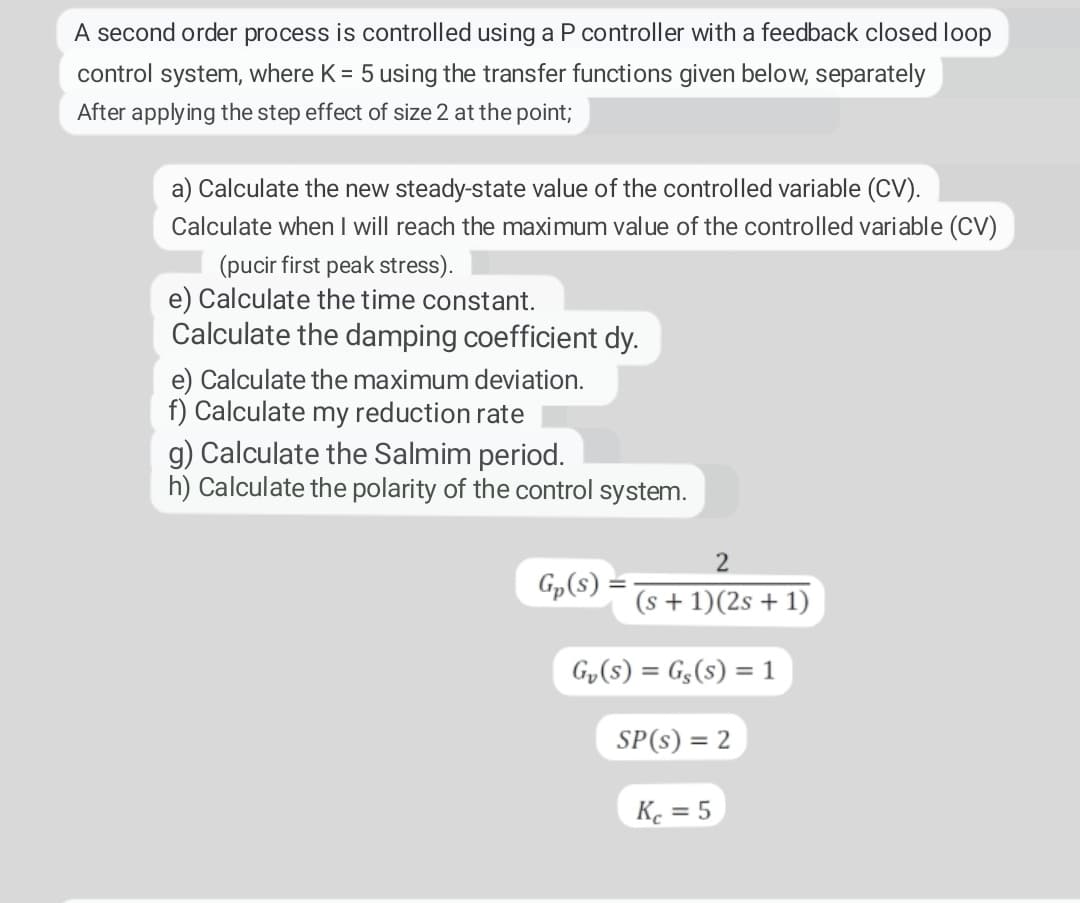A second order process is controlled using a P controller with a feedback closed loop control system, where K = 5 using the transfer functions given below, separately After applying the step effect of size 2 at the point; a) Calculate the new steady-state value of the controlled variable (CV). Calculate when I will reach the maximum value of the controlled variable (CV) (pucir first peak stress). e) Calculate the time constant. Calculate the damping coefficient dy. e) Calculate the maximum deviation. f) Calculate my reduction rate g) Calculate the Salmim period. h) Calculate the polarity of the control system. 2 Gp(s) (s + 1)(2s+1) G₁(s) = Gs(s) = 1 SP(s) = 2 K₁ = 5
A second order process is controlled using a P controller with a feedback closed loop control system, where K = 5 using the transfer functions given below, separately After applying the step effect of size 2 at the point; a) Calculate the new steady-state value of the controlled variable (CV). Calculate when I will reach the maximum value of the controlled variable (CV) (pucir first peak stress). e) Calculate the time constant. Calculate the damping coefficient dy. e) Calculate the maximum deviation. f) Calculate my reduction rate g) Calculate the Salmim period. h) Calculate the polarity of the control system. 2 Gp(s) (s + 1)(2s+1) G₁(s) = Gs(s) = 1 SP(s) = 2 K₁ = 5
Introduction to Chemical Engineering Thermodynamics
8th Edition
ISBN:9781259696527
Author:J.M. Smith Termodinamica en ingenieria quimica, Hendrick C Van Ness, Michael Abbott, Mark Swihart
Publisher:J.M. Smith Termodinamica en ingenieria quimica, Hendrick C Van Ness, Michael Abbott, Mark Swihart
Chapter1: Introduction
Section: Chapter Questions
Problem 1.1P
Related questions
Question

Transcribed Image Text:A second order process is controlled using a P controller with a feedback closed loop
control system, where K = 5 using the transfer functions given below, separately
After applying the step effect of size 2 at the point;
a) Calculate the new steady-state value of the controlled variable (CV).
Calculate when I will reach the maximum value of the controlled variable (CV)
(pucir first peak stress).
e) Calculate the time constant.
Calculate the damping coefficient dy.
e) Calculate the maximum deviation.
f) Calculate my reduction rate
g) Calculate the Salmim period.
h) Calculate the polarity of the control system.
Gp(s):
2
(s + 1)(2s + 1)
G₂ (S) = G₂ (s) = 1
SP(s) = 2
Kc = 5
Expert Solution
This question has been solved!
Explore an expertly crafted, step-by-step solution for a thorough understanding of key concepts.
Step by step
Solved in 4 steps with 12 images

Recommended textbooks for you

Introduction to Chemical Engineering Thermodynami…
Chemical Engineering
ISBN:
9781259696527
Author:
J.M. Smith Termodinamica en ingenieria quimica, Hendrick C Van Ness, Michael Abbott, Mark Swihart
Publisher:
McGraw-Hill Education

Elementary Principles of Chemical Processes, Bind…
Chemical Engineering
ISBN:
9781118431221
Author:
Richard M. Felder, Ronald W. Rousseau, Lisa G. Bullard
Publisher:
WILEY

Elements of Chemical Reaction Engineering (5th Ed…
Chemical Engineering
ISBN:
9780133887518
Author:
H. Scott Fogler
Publisher:
Prentice Hall

Introduction to Chemical Engineering Thermodynami…
Chemical Engineering
ISBN:
9781259696527
Author:
J.M. Smith Termodinamica en ingenieria quimica, Hendrick C Van Ness, Michael Abbott, Mark Swihart
Publisher:
McGraw-Hill Education

Elementary Principles of Chemical Processes, Bind…
Chemical Engineering
ISBN:
9781118431221
Author:
Richard M. Felder, Ronald W. Rousseau, Lisa G. Bullard
Publisher:
WILEY

Elements of Chemical Reaction Engineering (5th Ed…
Chemical Engineering
ISBN:
9780133887518
Author:
H. Scott Fogler
Publisher:
Prentice Hall


Industrial Plastics: Theory and Applications
Chemical Engineering
ISBN:
9781285061238
Author:
Lokensgard, Erik
Publisher:
Delmar Cengage Learning

Unit Operations of Chemical Engineering
Chemical Engineering
ISBN:
9780072848236
Author:
Warren McCabe, Julian C. Smith, Peter Harriott
Publisher:
McGraw-Hill Companies, The